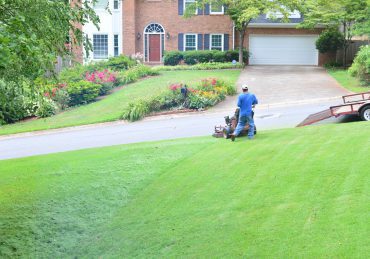In 2025, the average cost for hedge trimming services typically ranges from $429 to $600, influenced by factors such as hedge size and local demand. For smaller hedges under six feet, costs can start at $2.50 per foot, while taller hedges may reach $6 per foot. Urban areas often face higher rates compared to rural locations. Additional costs, like debris removal, can also affect the final charge. Regular maintenance can mitigate excessive expenses. Understanding these variables can help in budgeting for trim services while ensuring ideal hedge health and appearance. Investigate the details to make an informed decision.
Average Hedge Trimming Costs in 2025
The national average cost of hedge trimming in 2025 is about $275, though actual prices vary depending on the scope of the work and the complexity involved. For smaller, simpler jobs, such as trimming short or moderately sized hedges, the cost can ben on the lower end, around $100 to $150. These types of jobs usually involve hedges that are easily accessible, require minimal shaping, and don’t take much time or specialized equipment to maintain.
On the other hand, more complex jobs can push costs to the higher end, ranging between $317 to $939 or more. These projects might involve larger, taller hedges that require ladders or mechanical lifts, extensive trimming to maintain shape, or intricate hedge designed that demand precision. Additionally, jobs involved dense or fast-growing hedge species may require more effort to cut through the branches, increasing the time and labor costs.
Easily hire the best lawn & landscape pros working in your neighborhood.
Cost Per Hour
In 2025, the average hourly rate for professional hedge trimming typically ranges from $50 to $90 per hour. This rate can fluctuate based on several factors, including location. For example, in urban or high-demand areas, where landscaping services are more sought after, rates tend to be higher. Conversely, rural areas may offer lower hourly rates. The expertise of the service provider always plays a role, as more experiences or highly skilled trimmers may charge on the higher end of the scale, especially for intricate or precision work.
Additionally, the amount of labor required can affect the rate. For hedges that are tall, difficult to reach, or require shaping and design, the job becomes more labor-intensive, increasing the cost per hour. If the service includes tasks like debris removal or hedge health assessments, these additional services may raise the hourly rate as well.
Hedge Trimming Cost Estimator by Size
The size and scale of a hedge, particularly its length and height, play a significant role in determining the cost of hedge trimming services. First, length directly correlates with the amount of labor required to trim the hedge. A long hedge means more surface area to be trimming, which increases the time and effort needed. Professional trimmers typically charge by the hour or by the linear foot, so a hedge that extends across a larger distance with naturally result in higher costs due to the increased labor involved.
In addition to length, the height of the hedge is another critical factor. Taller hedges often require specialized equipment, such as ladders, scaffolding, or even powered platforms, especially if the hedge exceeds a height of 6 to 8 feet. Trimming a taller hedge also involves more risk for the trimmer, which could lead to higher fees to account for safety precautions and additional time. Moreover, high hedges may need more frequent maintenance since they are more exposed to the elements and can grow faster, leading to bulkier trimmings that require disposal, another cost factor.
Finally, a larger hedge, both in height and length, will produce more clippings and debris, which must be cleared and disposed of. This adds to the cost if the service includes removal and disposal. Some hedge trimming services charge extra for this task, depending on the amount of waste generated. Overall, the larger the hedge, the more time, equipment, labor, and disposal services are required, all of which increase the cost.
Height of the Hedge
Hedge height plays a crucial role in determining the overall cost of trimming, with shorter hedges typically incurring lower expenses compared to their taller counterparts.
For hedges under 6 feet, costs generally range from $2.50 to $4 per foot, while those exceeding this height can escalate to $4 to $6 per foot.
For instance, trimming a medium hedge that is 12 feet long and 6 feet tall may cost around $30 to $48. Conversely, extra-large hedges measuring 150 feet long and 12 feet tall can incur costs of up to $900.
Moreover, taller hedges require more labor, including ladder work, which can increase the costs considerably.
Professional hedge trimming services provide expertise, ensuring optimal outcomes for any height of the hedge.
Type of Hedge
Various types of hedges can greatly affect trimming costs, as each species may require different levels of care and maintenance.
For instance, trimming costs around shorter hedges (under 6 feet) typically range from $2.50 to $4 per foot, while taller hedges incur costs between $4 and $6 per foot.
Overgrown hedges, which demand additional labor and expertise, can substantially increase the overall hedge trimming costs.
The average national cost for hedge trimming in 2025 is approximately $429, influenced by hedge type and condition.
For example, a medium hedge measuring 12 feet long and 6 feet tall may cost between $30 and $48, while extra-large hedges can reach trimming costs up to $900, illustrating the variability in the cost of hedge maintenance.
Factors That Affect Hedge Trimming Costs
Several key factors influence hedge trimming costs, including the overall condition of the hedge, the frequency of trimming, and the time of year.
Well-maintained hedges typically incur lower costs compared to those that are overgrown, while regular trimming can prevent excessive charges in the long run.
Moreover, seasonal demand can affect pricing, with peak periods often resulting in higher service rates.
Easily hire the best lawn & landscape pros working in your neighborhood.
Time of Year
Seasonal timing plays a significant role in determining hedge trimming costs, with prices generally escalating during high-demand periods such as spring and summer. During these peak seasons, average costs can reach approximately $429.
Conversely, trimming hedges during off-peak seasons, like late fall or winter, may yield lower rates, as service providers often offer discounts to attract customers.
The ideal timing for hedge trimming also depends on local climate variations, which can affect both hedge health and service pricing.
Regular maintenance is essential in managing costs; overgrown hedges require more labor and time, leading to higher expenses.
Accessibility and Location
Hedges that are difficult to reach or located in specific geographic areas often incur higher trimming costs due to the additional effort involved. For instance, hedges positioned on steep slopes, behind fences, or near obstacles like building may require specialized equipment such as ladders, scaffolding, or even mechanical lifts. These challenges increase the time and labor needed, leading to higher service charges.
In certain geographic locations, costs can also rise due to local conditions. For example, in hilly or mountainous areas, the terrain itself adds complexity, while regions with extreme weather conditions may lead to fast hedge growth, requiring more frequent trimming. Additionally, remote or rural locations may see increased fees if the service provider has to travel long distances, while urban areas typically have higher labor costs due to demand and high living expenses. All of these factors combine to drive up the overall price of hedge trimming in such circumstances.
Cost of Related Services
In addition to hedge trimming, homeowners should consider related services that contribute to overall landscape maintenance.
Bush trimming, and hedge removal are essential tasks that can complement the aesthetic and health of outdoor spaces.
Understanding the costs associated with these services can aid in effective budgeting and planning for a well-maintained garden.
Bush Trimming
Bush trimming in 2025 typically costs between $110 and $440, with an average price of approximately $275, influenced by factors such as bush size and quantity.
Smaller bushes under 2 feet generally range from $3 to $6 each, while larger bushes over 6 feet can cost between $16 and $35.
Homeowners seeking bush trimming services may find discounts available for larger quantities, particularly for jobs involving 25 or more bushes.
Moreover, if debris cleanup is required, costs can increase by $25 to $500, depending on the volume of waste.
Hedge Removal
Hedge removal services in 2025 generally cost between $200 and $900, influenced by factors such as the size and complexity of the job.
The size of the hedge is a major cost factor; larger and taller hedges take more time and effort to remove, especially if they have dense or thick branches.
Many companies charge between $2 to $4 per foot for hedge removal services, with prices varying based on geographic location and demand.
It is vital to factor in additional fees for debris disposal, which can range from $35 to $100, depending on local regulations.
Easily hire the best lawn & landscape pros working in your neighborhood.
Lawn Mowing
Lawn mowing services typically range from $35 to $100 per visit, influenced by factors such as yard size and geographic location. The average cost for lawn mowing services is approximately $62 per hour, with pricing structured around a flat rate or hourly basis.
Most residential lawns require mowing every 1 to 2 weeks during the growing season to maintain a healthy appearance. Homeowners can save money by bundling lawn mowing with other landscaping services, such as hedge trimming or mulching, which may lead to discounts.
DIY Cost Hedge Trimming vs. Hiring a Pro
When considering whether to tackle hedge trimming as a DIY project or to hire a professional, homeowners must weigh the potential cost savings against the required time, skill, and safety precautions involved.
DIY hedge trimming can save you money initially, with equipment costs averaging around $426. However, it requires significant time investment and expertise to avoid safety risks and plant damage.
In contrast, professional hedge trimming services typically charge between $200 and $600, with an average cost of about $429. Hiring a lawn care expert guarantees proper techniques and tools are employed, leading to better results and potentially lower long-term maintenance costs.
This makes it a worthwhile investment for many homeowners.
Cost of Hedge Trimming by Location
The cost of hedge trimming can vary considerably based on geographical location, reflecting differences in demand, living expenses, and local market conditions.
In urban areas, hedge trimming costs can average up to $600, while rural locations may offer services for as low as $200, highlighting significant regional pricing trends.
The national average cost for hedge trimming in 2025 stands at approximately $429, but this figure can fluctuate depending on local factors.
Furthermore, specific rates for trimming hedges range from $2.50 to $6 per foot, influenced by hedge height and complexity.
Local regulations regarding debris disposal and landscaping practices further impact overall costs, making it essential for homeowners to take into account geographic location when budgeting for these services.
Frequently Asked Questions (FAQ)
How Long Does It Take to Trim a Hedge?
The time required to trim a hedge varies considerably, typically ranging from 30 minutes to 2 hours, influenced by factors such as hedge size, complexity, and condition, with larger or overgrown hedges requiring additional time.
What’s the Best Time of Year to Trim My Hedges?
The best time of year to trim your hedges depends on the climate and plant type, but generally, early spring and late summer are ideal. Spring trimming encourages new growth, while late summer trims help maintain shape after the peak growing season. For flowering hedges, it’s best to trim right after they bloom to avoid cutting off future flowers. Avoid heavy trimming in late fall or winter, as frost can damage freshly cut branches. In warmer climates, light trimming can be done year-round, but avoid the hottest periods to prevent plant stress.
How Far Can You Trim Back Hedges Without Damaging Them?
To prevent plant damage or stunted growth, it’s important to follow safe trimming guidelines. Avoid cutting more than one-third of the hedge’s total growth at one time, as excessive trimming can stress the plant and hinder future growth. For evergreens, trim lightly to maintain shape without cutting into old wood, as they may not regrow from those areas. For deciduous hedges, you can prune more aggressively, but still avoid over-cutting. Always use sharp tools to make clean cuts, and trim during the plant’s dormant season or after flowering to minimize stress and promote healthy regrowth.
It’s important for homeowners to get quotes from reputable services to ensure quality work and fair pricing when hiring for hedge trimming. By comparing quotes from trusted providers, you can avoid hidden fees and ensure the job is done professionally. One convenient option is LawnGuru, our easy-to-use platform connects you with reliable, vetted professionals for hedge trimming and other landscaping needs. LawnGuru allows you to quickly compare prices and book services online, giving you confidence in choosing the right provider. Using a trusted service like LawnGuru ensure both convenience and peace of mind.




